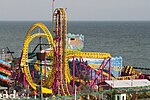Southend Cliff Railway
1912 establishments in England4 ft 6 in gauge railways in EnglandBuildings and structures in Southend-on-SeaFunicular railways in the United KingdomInclined elevators ... and 2 more
Transport in Southend-on-SeaUse British English from May 2017

The Southend Cliff Railway, or Southend Cliff Lift, is an inclined lift in the English city of Southend-on-Sea, constructed in 1912. The lift operated for the first time on Bank Holiday Monday, in August of that year.
Excerpt from the Wikipedia article Southend Cliff Railway (License: CC BY-SA 3.0, Authors, Images).Southend Cliff Railway
Western Esplanade, Southend-on-Sea Westcliff-on-Sea
Geographical coordinates (GPS) Address Nearby Places Show on map
Geographical coordinates (GPS)
| Latitude | Longitude |
|---|---|
| N 51.533738 ° | E 0.71093 ° |
Address
Southend Cliff Lift
Western Esplanade
SS0 7QD Southend-on-Sea, Westcliff-on-Sea
England, United Kingdom
Open on Google Maps









